Qualcomm’s New 3rd Generation Snapdragon X60 5G Modem, Built on 5nm
by Dr. Ian Cutress on February 18, 2020 7:30 AM EST- Posted in
- Smartphones
- Qualcomm
- 5G
- mmWave
- Modem
- Sub 6 GHz
- Snapdragon X60
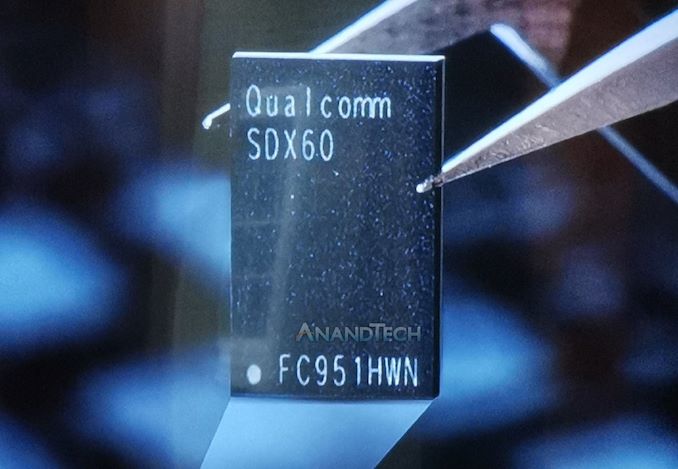
To date Qualcomm has promoted two key standalone 5G modems for widespread adoption: the Snapdragon X50 and the Snapdragon X55. Today the company is disclosing details on its upcoming 3rd generation 5G modem design, the Snapdragon X60, which is being promoted as the premium offering for smartphones, industrial, and commercial designs that require a discrete 5G modem. Key features of this modem include the fact that it is built on a 5nm process, supports carrier aggregation between Sub-6 and mmWave, and offers up to 7.5 Gbps download speeds.
The fact that Qualcomm is outright saying that their modem is going to be built on 5nm at this point of the game is very interesting, especially given TSMC’s recent disclosures on the capability of its 5nm process and its current timeline of development.
With the Snapdragon X60, Qualcomm is promoting support for more features of 5G, such as carrier aggregation between Sub-6 GHz bands in FDD/TDD (similar to LTE carrier aggregation), and support for simultaneous carrier aggregation between Sub-6 GHz and mmWave 5G bands. This leads to big jumps in peak bandwidth support, with Qualcomm listing up to 7.5 Gbps download over mmWave, 3 Gbps upload, and up to 5 Gbps download over Sub-6 GHz.
These peak speeds with the X60 modem is going to be achieved through new mmWave antenna modules. For the X50/X55, Qualcomm introduced its QTM525 module for mmWave, in a slim packaging to help enable the technology. Despite the sleek stature, the X50/X55 modems supported four of these modules, and Qualcomm recommended a minimum of three – the replacement of which did require these devices to be of a specific minimum thickness to ensure complete coverage. The new QTM535 module is promoted to be thinner, reducing that requirement.
Unfortunately the diagram showed by Qualcomm of the new module (as they didn’t have a physical one to show us) was not to scale, so no real conclusions could be drawn to the old module. Qualcomm also stated that they were not discussing dimensions at this time, despite the fact that the QTM525 launch was all about the dimensions. The new module can support 26 GHz, 28 GHz, and 39 GHz, enabling wider support. Qualcomm is going to keep its recommendation to vendors to use at least 3 in a connected device.
Alongside the modem and the mmWave antenna, Qualcomm is also offering the full RF front end for Sub-6 GHz. Qualcomm was proud to promote last year at its Tech Summit that out of the 150 devices that were using X50/X55 modems, all of them were using Qualcomm’s RF front-end solution. The X60 will similarly be a full stack offering.
Rollout of Qualcomm’s 5G modems has been a varied affair, with the time between the initial announcement of the first generation X50 and it actually launching into consumer devices being around two years. The process was sped up with X55, with a quicker time to market and eventually widespread deployment for consumer devices through the end of 2019 and likely for all of 2020. There was no doubt that Qualcomm was going announce its next generation design at some point, and with X55 in full swing, that time would appear to be now. When asked regarding timeframe of the X60, Qualcomm stated that they’re not sticking to any timeframe, with a spokesperson saying ‘these things go through revisions’. It is worth noting that for 5nm, TSMC has not yet entered high-volume manufacturing on this node yet (it will do soon, but yields are still low according to the ISSCC 2019 disclosure in December), and Samsung is further behind. So the exact timeframe for X60 rollout maybe sometime in 2021 at our best guess. Qualcomm has an annual Tech Summit in December, so we might see some of the first X60 reference designs at that event, likely with early silicon or the first batches of production silicon.
With MWC now cancelled, we might expect to see updates to the Snapdragon X60 news later in the year, perhaps at IFA in late August, or at Qualcomm’s own 5G analyst event. Then there’s always the Tech Summit in December.


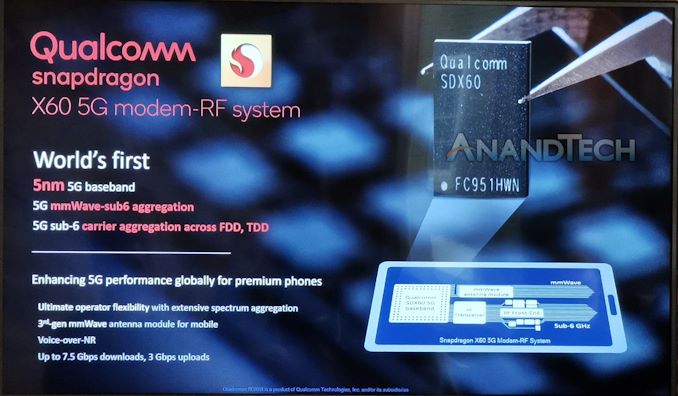
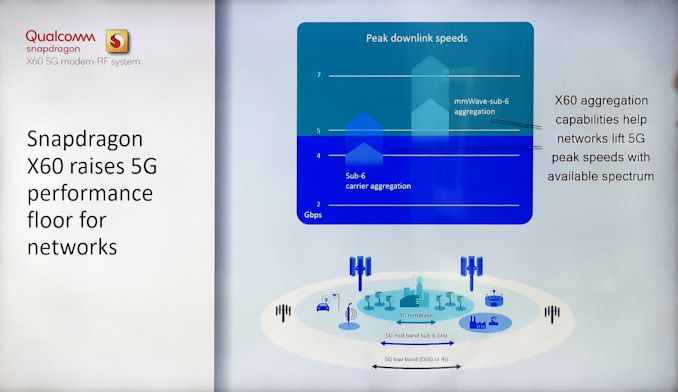

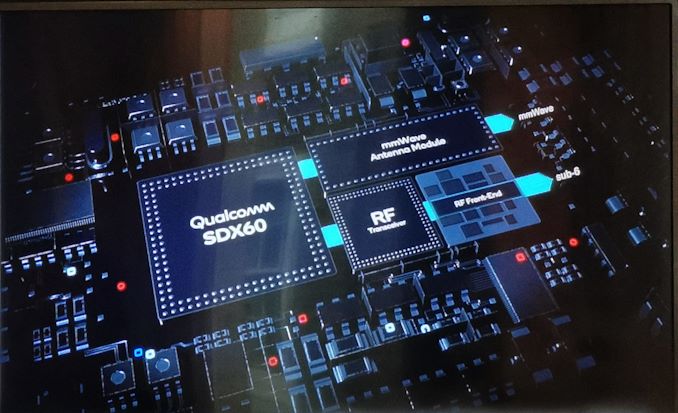
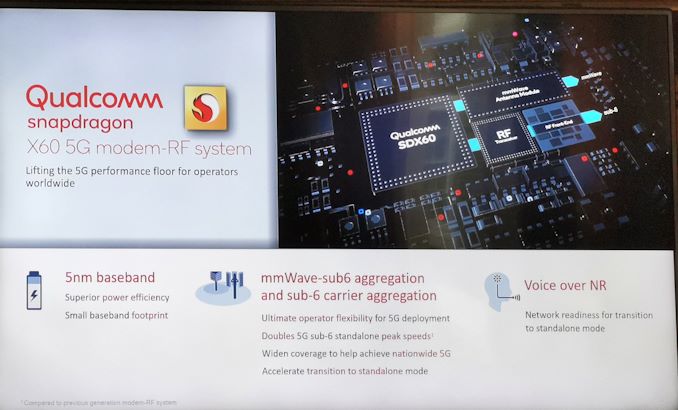








50 Comments
View All Comments
shabby - Tuesday, February 18, 2020 - link
How big are these 5g modules and how many are needed in a phone?1_rick - Tuesday, February 18, 2020 - link
They're not saying and they recommend at least 3.SydneyBlue120d - Tuesday, February 18, 2020 - link
Do You think the Snapdragon 865 successor will integrate it?yeeeeman - Tuesday, February 18, 2020 - link
It is pretty clear to me that this is still a standalone solution. 5G modems are BIG, hot and require lots of pins/power. I don't think they can integrate them (at least that is the case for X55 and now X60) into the main SoC.Tbh, if I were to buy a new phone now, I would buy a 4G variant of the SD865. 5G is still in its early days.
TheUnhandledException - Tuesday, February 18, 2020 - link
Qualcomm has said they CAN integrate it and in fact both Qualcomm and Samsung do at the midtier level. The discrete modem is simply due to the rapidly changing tech and time to market concerns. The radios were ready before the SoC allowing more time for testing the RF side of the house. The modems will be integrated eventually. Not sure if that will happen in the successor of the 865 or the one after that but it will happen.Raqia - Tuesday, February 18, 2020 - link
The TSMC 5nm touts improvements in analog density:https://semiwiki.com/semiconductor-manufacturers/i...
Qualcomm has typically incorporated prior gen. modems into their leading edge SoCs so the 875 will probably have (a version with) the x55 integrated.
yeeeeman - Tuesday, February 18, 2020 - link
Ok, fair enough, didn't thought about this.s.yu - Tuesday, February 18, 2020 - link
I don't see your point, the integrated midrange 5G modems are smaller and slower, arguably how they should be since the speeds won't be supported by infrastructure, but still.levizx - Wednesday, February 19, 2020 - link
I don't see YOUR point. Both Exynos 980/765G are cheap 5G solutions, of course they are slower. What else do you expect? In fact MTK D1000 has a 5G modem that performs on par with X55 @sub-6. With next-gen 5nm SoC there's no way Qualcomm can't have integrated X55/X60, they just chose not to because it's cheaper to supply the discreet modem to everyone including Apple.s.yu - Wednesday, February 19, 2020 - link
Well, first of all, if the lower performance is acceptable, then obviously it could be integrated, but this is not the low performance variant, that's why it can't be integrated, and when we say it can't, of course it's in the practical business sense, speaking in costs and profits, not feasibility in the realm of physics.As for MTK, they're known to look good on paper(mmWave also takes up too much die area), OTOH, the infrastructure won't support a test of peak speeds, which is why I said slow is "arguably how they should be", because the flagship modems are overkill, but it's not a discussion of whether or not overkill is otherwise justified because this issue is far from restrained to modem performance, so unless they seriously mess up, they won't be faulted for not reaching their claimed performance, simply because the claims can't be verified.
So claiming that discrete X55/X60 is "cheaper" compared to potential integration is not an argument because cheaper could mean the difference between marketable or not(with the gain in efficiency of integrated considered), and I don't think you can easily brush off the concentration of heat and power @yeeeeman noted either.